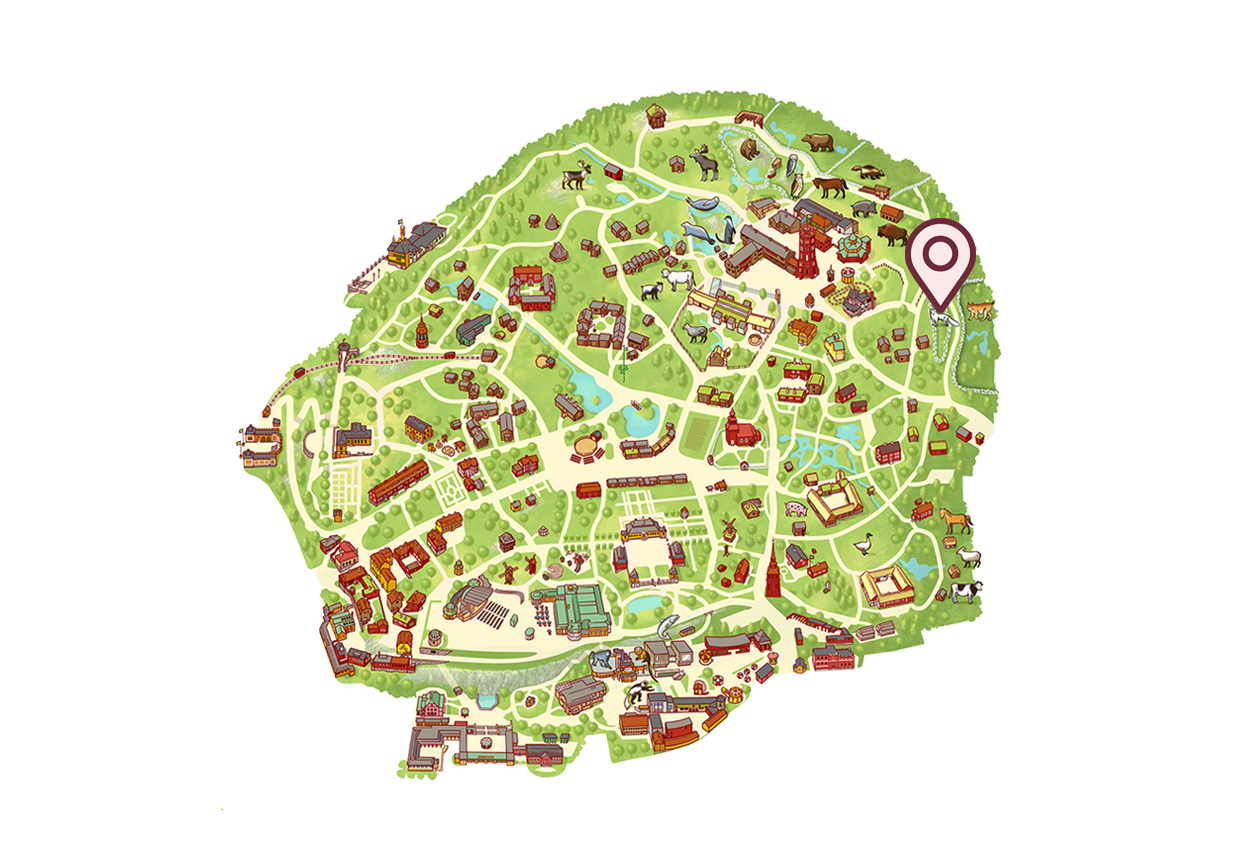- See and do
- The Zoo
- Animals at Skansen
- Arctic fox
Arctic fox
The protected Arctic fox is one of Sweden’s most endangered mammals. It lives on tundra and bare rock, and can survive in very cold temperatures. The Arctic fox is in great need of human assistance to survive in the long term, and is part of Skansen’s species conservation work.
-
The Arctic fox lives on the tundra and can be found in Arctic areas. In Scandinavia it is mainly found in the mountains, above the tree line. Historically, the Arctic fox was found throughout the Swedish mountain range, from Norrbotten to Dalarna, but is now endangered and can only be found in a few limited areas in Västerbotten and Jämtland.
White, blue or sand coloured
The Arctic fox is a relatively small animal, at around 70 centimetres long, and weighs 2.5–5 kg. Its fur can be three different colours: white, blue or sandy. In summer, the white Arctic fox’s fur is usually brownish-grey on the face, the back and the outside of the legs, while most of the sides and the underside of the body are greyish-white to yellowish-white. -
Faktaruta om fjällräv
Scientific name:Vulpes lagopus
Weight:2,5–5 kg
Length:approx 70 cm
Number of young:2–15, max 18
Lifespan:5–8 years
Eats:Small rodents such as lemmings, grouse, frogs, eggs and carrion
-
The bushy tail can be the same colour as the back or slightly dark on the upper side at the base, and is otherwise the same colour as the fox’s underside. During the winter, the entire coat turns white to adapt to the snowy environment. The blue Arctic fox is steel blue in the winter and dark brown in the summer. The more unusual sand-coloured Arctic fox is the same colour all year round.
Hair-covered foot pads and insulating fur
The Arctic fox is well adapted to the cold climate, and can cope with temperatures of down to 40 degrees below zero thanks to its hair-covered foot pads and its thick, insulating fur. Its legs also act as heat exchangers in cold weather, meaning that the blood at the foot pads is at a much lower temperature than the blood in the body.Mainly eats small rodents
Arctic foxes are omnivores whose diet consists mainly of small rodents, especially lemmings, but also grouse and hares, as well as eggs and baby birds in the summer. In late summer they may also eat berries. In winter, carrion is almost a necessity for Arctic foxes.Lives in pairs
Arctic foxes are monogamous animals that stay together throughout their lives. They dig out large dens where they give birth to their young. They mate in March, and five to ten cubs are born in May or June – sometimes more when food is plentiful. One or two yearlings will sometimes stay behind to help with their new siblings. The dens can have dozens of exits. They are used year after year, and are therefore covered with lush grass that can be seen from a distance. The cubs stay near the den until the autumn, after which they migrate. Young Arctic foxes face an uncertain future, with survival rates ranging from zero to 20 percent – mainly due to food shortages.An endangered species
At the beginning of the 20th century the species was still common in Sweden, and in good years the population probably peaked at nearly 10,000 individuals. Extremely intensive hunting was the main reason why the population was deemed to be in need of total protection by 1928. Despite this protection, however, the Arctic fox has never recovered and the number of Arctic foxes is now stable but very low, and around 2000 it was estimated that only 40–60 individuals remained.Conservation work
The Swedish Arctic Fox Project began at Stockholm University in the 1980s. The results of this research project have helped us to understand more about their living conditions and to follow their development. The Arctic foxes arrived at Skansen in 2022. They are also part of the Swedish Arctic Fox Project, and are an important aspect of our species conservation work.The Arctic fox is classified as ‘Endangered’ according to the Swedish Species Information Centre’s red list.
-
About the Swedish Arctic Fox Project
The Swedish Arctic Fox Project is a research group at Stockholm University that researches the Arctic fox’s interaction with other species in the ecosystem, as well as its survival, demographics and genetics. Each year, the project maps dens, monitors rejuvenations, weighs and tags cubs, and carries out genetic studies and inventories of rodents and birds. The fieldwork is done by around 50 researchers, students and volunteers, together with the county administrative boards’ nature monitors. In total, the project’s participants spend more than 900 days in the field and visit more than 250 dens. This knowledge then forms a basis for measures that can be taken to help the Arctic fox.
The project works together with the county administrative boards in the relevant counties to give the foxes better access to food. It also tries to reduce the number of competing red foxes in the mountains above the tree line. Thanks to this long-term work, the Arctic fox population has doubled in some areas. The population has increased from 40 to 60 individuals in 2000 to 350 to 450 twenty years later.
Skansen has cooperated with the Swedish Arctic Fox Project for some time, contributing toward the Arctic fox’s conservation by:
- Showing Arctic foxes at Skansen, thereby increasing knowledge about and interest in the conservation of the species
- Contributing funds for support feeding and research
- Helping with field work
- Working with other animal parks to establish a genetically healthy reserve population
You can find the Arctic fox here
